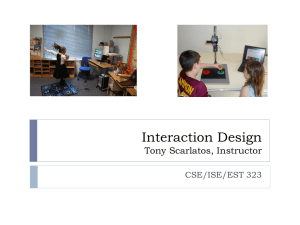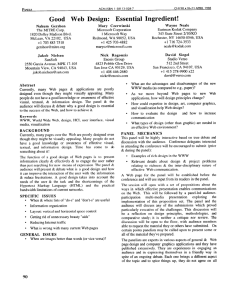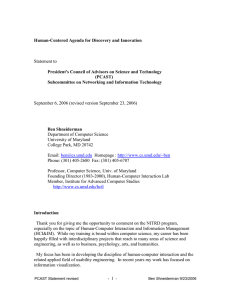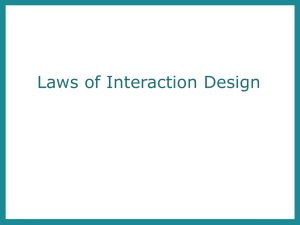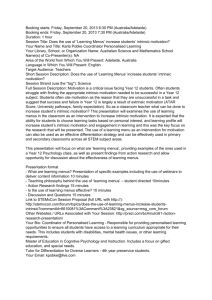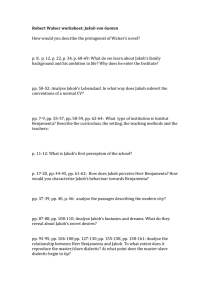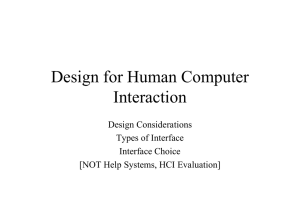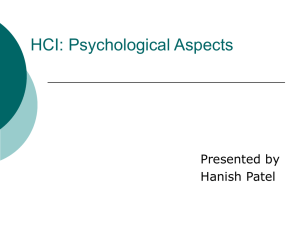Interaction Design - CS Multimedia Lab
advertisement
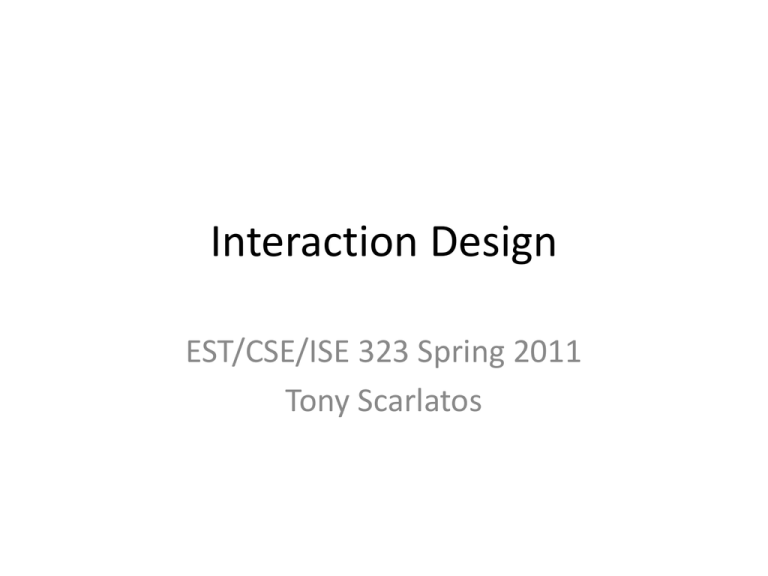
Interaction Design EST/CSE/ISE 323 Spring 2011 Tony Scarlatos Top 2 Principles • Recognize Diversity – “The average computer user” is a fiction – Age, Gender, Culture, Abilities and Disabilities, Education, Socioeconomic Status, and many other factors distinguish one user from another • Prevent Error – Using a computer should always make a task easier than not using one – Productivity gains and satisfaction come from optimal design, losses and frustration come from inferior design Howard Gardner • Hobbs Professor of Cognition and Education at the Harvard Graduate School of Education. • Recipient of a MacArthur Prize Fellowship in 1981. • Proposed a theory of Multiple Intelligences in 1983. One view of diversity: Multiple Intelligences Ben Shneiderman • Ph.D. from Stony Brook University Computer Science Dept. in 1973. • CS Professor at the HCI Lab at Univ. of Maryland, College Park. • Introduced the term “Direct Manipulation Interface” in 1983. • Developed Eight Golden Rules of Interface Design. • Recipient of the ACM CHI Lifetime Achievement Award 2001. Ben Shneiderman’s 8 Golden Rules of HCI Design (1 – 4) • • • • Strive for consistency – Consistent actions should be required in similar situations. – Identical terminology should be used in prompts, menus, and help screens. – Consistent color, layout, capitalization, and fonts should be employed throughout. Enable frequent users to use shortcuts – To increase the pace of interaction use abbreviations, special keys, and macros. Offer informative feedback – For every user action, the system should respond in some way. – Report on the state of the system. Design dialogs to yield closure – Sequences of actions should be organized into groups with a beginning, middle, and end. Feedback at the completion of a group of actions shows the user their activity has completed successfully. Ben Shneiderman’s 8 Golden Rules of HCI Design (5 - 8) • • • • Offer error prevention and simple error handling – Design forms so that users cannot make a serious error; for example, prefer menu selection to form fill-in, and do not allow alphabetic characters in numeric entry fields. – If users make an error, instructions should be written to detect the error and offer simple, constructive, and specific instructions for recovery. Permit easy reversal of actions Support internal locus of control – Surprising system actions, tedious sequences of data entries, inability or difficulty in obtaining necessary information, and inability to produce the action desired all build anxiety and dissatisfaction. Reduce short-term memory load – Reduce short term memory load by designing screens where options are clearly visible, or using pull-down menus and icons. Jakob Nielsen • Ph.D. in human-computer interaction from the Technical University of Denmark in Copenhagen. • Sun Microsystems Distinguished Engineer. • Inducted into the Scandinavian Interactive Media Hall of Fame (2000). • Inducted into the ACM Computer-Human Interaction Academy (2006). Jakob Nielsen’s Ten Usability Heuristics (1 – 5) Visibility of system status The system should always keep users informed about what is going on, through appropriate feedback within reasonable time. Match between system and the real world The system should speak the users' language, with words, phrases and concepts familiar to the user, rather than system-oriented terms. Follow real-world conventions, making information appear in a natural and logical order. User control and freedom Users often choose system functions by mistake and will need a clearly marked "emergency exit" to leave the unwanted state without having to go through an extended dialogue. Support undo and redo. Consistency and standards Users should not have to wonder whether different words, situations, or actions mean the same thing. Follow platform conventions. Error prevention Even better than good error messages is a careful design which prevents a problem from occurring in the first place. Either eliminate error-prone conditions or check for them and present users with a confirmation option before they commit to the action. Jakob Nielsen’s Ten Usability Heuristics (6 – 10) Recognition rather than recall Minimize the user's memory load by making objects, actions, and options visible. The user should not have to remember information from one part of the dialogue to another. Instructions for use of the system should be visible or easily retrievable whenever appropriate. Flexibility and efficiency of use Accelerators -- unseen by the novice user -- may often speed up the interaction for the expert user such that the system can cater to both inexperienced and experienced users. Allow users to tailor frequent actions. Aesthetic and minimalist design Dialogues should not contain information which is irrelevant or rarely needed. Every extra unit of information in a dialogue competes with the relevant units of information and diminishes their relative visibility. Help users recognize, diagnose, and recover from errors Error messages should be expressed in plain language (no codes), precisely indicate the problem, and constructively suggest a solution. Help and documentation Even though it is better if the system can be used without documentation, it may be necessary to provide help and documentation. Any such information should be easy to search, focused on the user's task, list concrete steps to be carried out, and not be too large. Six other laws (1 – 3) • Moore's Law: (1950) Every 18 months, the number of transistors on integrated circuits will double. Designers can expect devices to become smaller, faster, cheaper and more powerful. Design for the future... not for the now. • Fitts Law: (1954) The time it takes to move from a starting position to the final target is determined by the distance to the target and the size of the target. Relates to icon size (bigger), button placement (edges of the screen) and contextual (pop-up) menus. • Hick's Law: (1952) The time it takes for users to make decisions is based on the number of choices they have. Users will make choices more quickly from one menu of 10 items than two menus of 5 items. Speed is also determined by familiarity of choices, and format of choices. Six other laws (4 – 6) • Miller’s Magical Number 7: (1956) The human mind is able to remember information best in chunks of 7 (plus or minus 2). For short-term memory, information is best presented in chunks of 5 to 9 pieces. • Tesler's Law: There is a point beyond which a process cannot be simplified further, and the complexity can only be transferred from one place to another. Designers should strive to distribute complexity broadly. • Poka-Yoke Principle: From the Japanese (Toyota)- avoiding (yokeru) inadvertent errors (poka). Designers put constraints on devices or products to prevent errors. Dan Saffer’s Rules Qualities of Good Interaction Design: Trustworthy - Appropriate Smart - Responsive - Clever Ludic (playful) – Pleasurable
